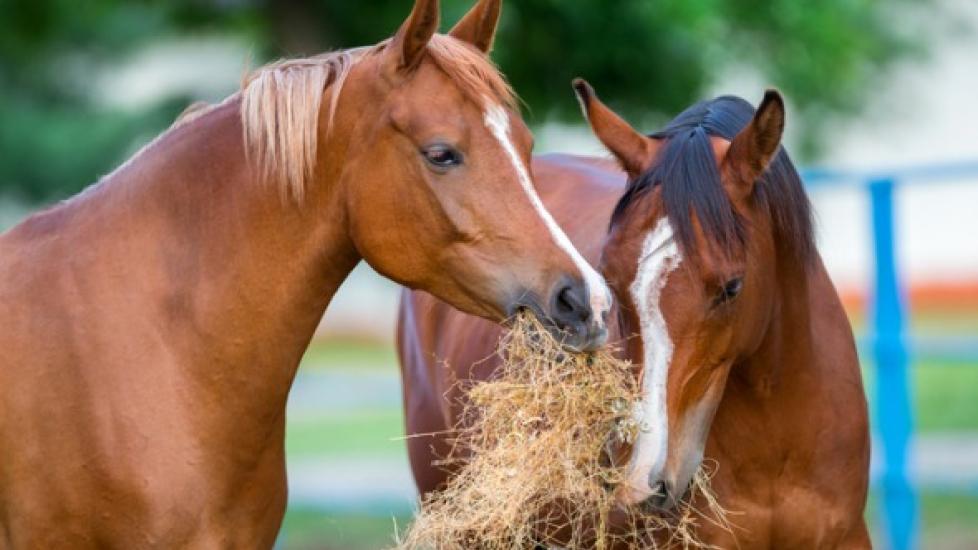How to Keep Moldy Horse Hay from Endangering Your Horse
For horse owners who don’t have their own hay fields, the process of growing, cutting, drying and baling hay can be a bit mysterious. It can go wrong in a number of ways.
If hay is harvested at the wrong time, nutrient loss and mold become more likely. Poisonous plants and pests can also end up in the hay, increasing the chance of having a sick horse on your hands.
Considering how sensitive horses are, it’s wise to source your hay from a responsible and reliable vendor. In addition, you need to check each bale you offer your horse. A quick quality inspection at feed-time could save you a huge headache in the future.
Mold is one of the most common hay hazards, but fortunately, you can protect your horse from both mold spores and the toxins (mycotoxins) that some molds produce.
Why Is Moldy Hay Dangerous?
Moldy hay frequently causes respiratory problems in horses. Recurrent airway obstruction, commonly known as heaves, is a lung disease that compromises a horse’s ability to breathe. It is similar to asthma in humans and is a chronic condition that can only be managed, not cured.
Potential signs of heaves include:
- Coughing
- Nasal discharge
- Increased respiratory rate
- Labored breathing
- The presence of a “heave line” caused by abdominal muscles enlarging to help with breathing
Mycotoxins can also cause digestive problems such as colic, diarrhea and weight loss. A weakened immune system and lack of nutrient absorption also make the horse more susceptible to a range of health issues. Organ damage can occur, including liver and kidney failure. Depending on the severity of the reaction, the toxins can lead to death. Reproductive issues are another consequence of eating moldy hay. Mares may have unexpected abortions, stillbirths or produce a foal with congenital defects.
How Does Hay Become Moldy?
Mold develops when moisture can’t evaporate in an appropriate amount of time. Sometimes this happens around harvest time, in which case your best defense is a knowledgeable hay farmer.
Cutting and drying hay is a delicate business. If hay is cut too early, the moisture content will be too high and risk mold growth, but if it’s cut too late, some of the desired nutrients will be lost. Luck also plays a role. All hay farmers can tell stories of how an unexpected rain storm drenched their crop after it was cut and supposed to be drying in the field.
Hay can also grow mold due to improper storage. Hay must be stored under dry conditions, preferably off the ground. If it’s impossible to store hay in a barn or storage shed, keeping it under a tarp or other protective material will help, but this is less than ideal. You’ll also need to put pallets or a waterproof barrier between the hay and the ground or moisture will seep in and adversely affect the bales at the bottom of your stack.
Proper ventilation reduces the moisture content in hay and is particularly valuable in areas of high humidity. Even carefully produced and stored hay can end up with some mold inside, so checking your hay before feeding is still always necessary.
How to Protect Your Horse From Moldy Hay
To best protect your horse from moldy hay, do an inspection before feeding it. Even if most of a bale is healthy, mold can exist in just one or two flakes.
Before giving your horse any hay, take a moment to check the following:
- Scent. Is there any smell you don’t recognize? A mildew scent would be an obvious red flag, but any unusual smell should draw your attention.
- Color. If the hay is discolored, set it aside. Discoloration can indicate heat damage, moisture or problems during the curing/baling process.
- Dust. All hay is a bit dusty, but excessive dust suggests that the hay may have once been wet and has now dried.
- Uniformity. Confirm that the hay is free of strange plants, insect and other foreign objects.
If you have to travel and are worried about conditions while in transport or at your destination, consider using a bale bag. Make sure to choose a bag with built-in ventilation, like Derby’s Originals extra large hay bale cover. Horse hay bags are useful for maintaining freshness as well as keeping waste to a minimum.
Instead of tossing your horse’s hay for the day on the ground, you can place it in a hay net or feeder. Any hay feeder for horses should be installed at a height that allows horses to eat with their heads down. Placing it too high increases the likelihood that horses will inhale dust and mold spores.
If you’re concerned about the quality of local hay sources, cubes or compressed bales can be good solutions. Options like the Standlee Grab & Go premium alfalfa compressed bale are popular because they are shrink-wrapped after being cut, dried and baled at the optimal time.
If you’ve already purchased horse hay and think there might be a mold issue, you can also have your hay tested. Some tests can be completed at your barn while others take a little longer, but in either case, the results will provide you with peace of mind.
Image via iStock.com/LOSHADENOK
